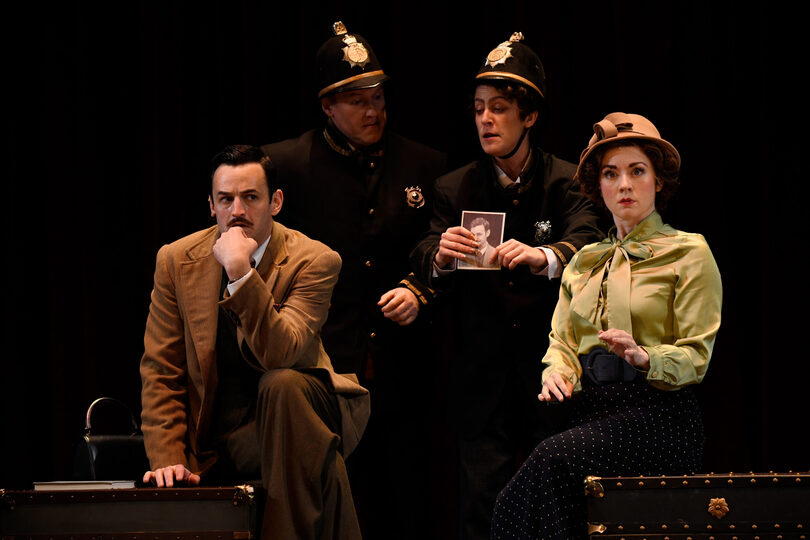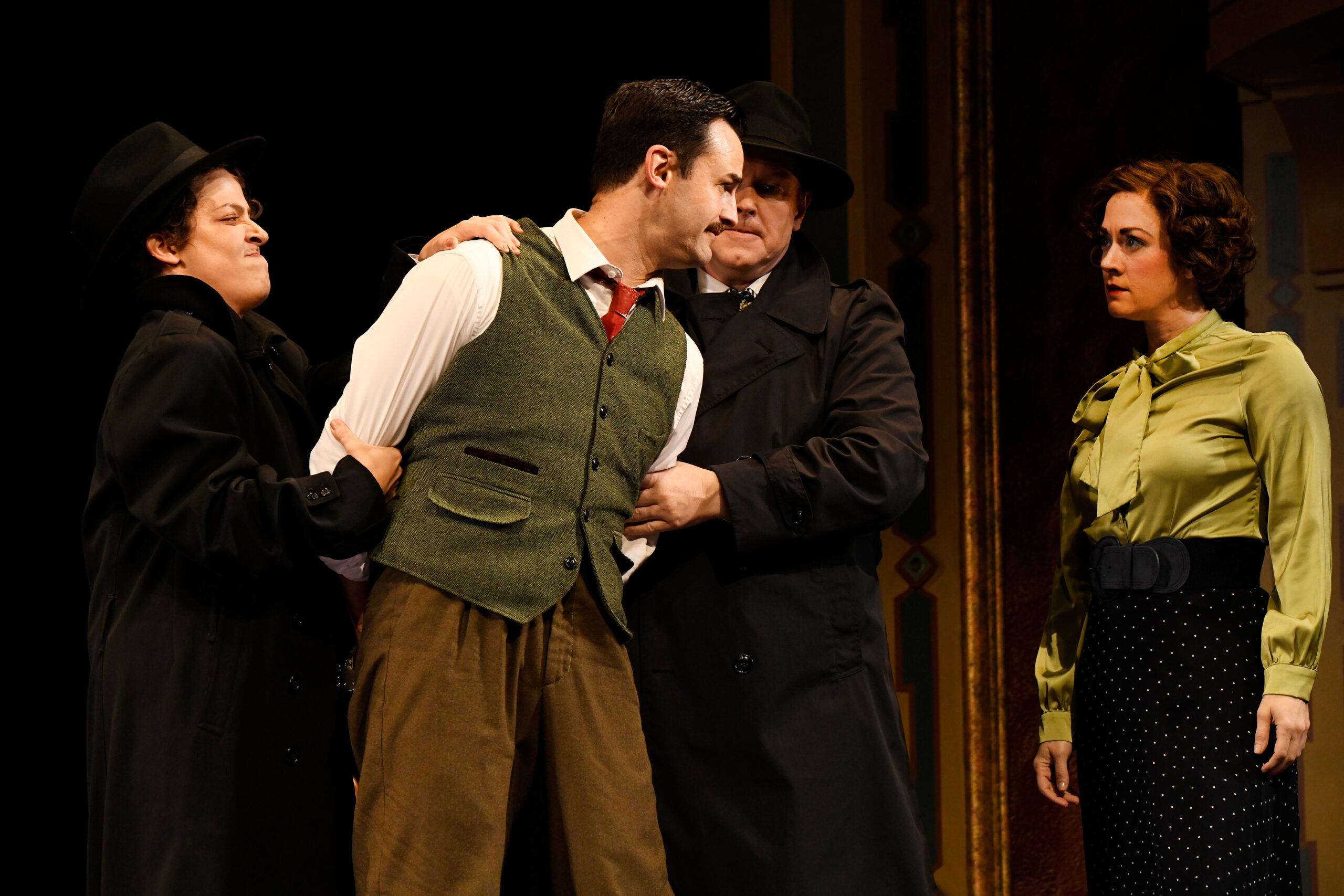4 actors, 139 characters: Kitschy comedy ‘The 39 Steps’ comes to Syracuse Stage

Jürgen Hooper, Michael Stewart Allen, Ema Zivkovic and Tyler Meredith, in Syracuse Stage's Production of "The 39 Steps.” The play has gone through many iterations, from the original book to the Alfred Hitchcock movie to multiple play adaptations. Courtesy of Brenna Merritt
Get the latest Syracuse news delivered right to your inbox.
Subscribe to our newsletter here.
When English playwright and actor Patrick Barlow was approached to play the leading role in an earlier edition of the play “The 39 Steps” in 2004, he declined. He knew he could write it better.
Barlow did just that, and his readaptation premiered in 2005 at the West Yorkshire Playhouse. It came to the historic West End in 2006, running for nine years and becoming one of the longest-running plays in the district’s history.
“It was a bit cheeky of me,” Barlow said. “The book is absolutely nothing like the film. And my play is absolutely nothing like the book.”
Barlow’s “The 39 Steps” is running through Nov. 9 at Syracuse Stage. It was adapted from the Alfred Hitchcock film, which was inspired by the 1915 novel of the same name by John Buchan. The play follows Richard Hannay as he comically falls into a life of espionage, secrecy and international mysteries amongst a host of other exaggerated characters — all performed by only four actors.
Barlow said the “posh British” humor pokes fun at the deeper issue of mistrust in Britain’s government and economic depression following World War I. The loneliness and lack of community Hannay experiences expose the isolation citizens face, and his accidental involvement in spy conspiracies demonstrates how easily masses fell to wartime propaganda, Barlow said.
In total, the cast of four plays 139 different characters. They use minimal permanent sets and flexible props to take the audience from Hannay’s London flat, to a train moving through the British landscape, to the Scottish countryside. All the while, actors incorporate slapstick humor within dark themes.
With a small cast, quick costume changes and prop handoffs are needed for the performance to succeed. Indianapolis-based stage manager Becky Roeber said that this production had the unique challenge of starting its run at the Indiana Repertory Theatre and transferring to Syracuse Stage in October.
“It’s my first time transferring with a show,” Roeber said. “I have a really amazing tech staff back there: four deck crew, two wardrobe crew and my mixer and light board operators.”
The leading actors, Tyler Meredith and Jürgen Hooper, said the play is an opportunity for them to strengthen their ability to perform in a fast-paced environment.
Hooper, who plays Richard, said that as a Hitchcock fan, playing a role inspired by his work is a privilege. However, for this production, he decided not to rewatch the film before developing his character.

A cast of only four (Jürgen Hooper, Michael Stewart Allen, Ema Zivkovic and Tyler Meredith) plays over 100 characters in “The 39 Steps.” Each actor having to play multiple characters challenged their versatility, Patrick Barlow said. Courtesy of Brenna Merritt
“The film is so serious,” Hooper said. “Hannay is a pretty sedate, stiff upper lip, mid-thirties man. The idea of Hitchcock is a thriller, horror director, but he actually had an incredible humor about him.”
Barlow saw the opportunity to transform the Hitchcockian thriller into a comedic work by incorporating physical comedy, he said. He said at the film’s core, it’s a story about a man being exposed to new things. While Hitchcock takes that in a mysterious, frightful adventure, Barlow said adding humor turns fear into laughter.
As a play based on an older novel and film, the comedic nature could easily come off as dated, Hooper said. The physical comedy style unites contemporary American audiences with post-war Brits, Barlow said.
“American audiences like the Englishness of it,” Barlow said. “People like the uptightness of the English. Americans laugh at that.”
Barlow was first drawn to theater and drama writing when he realized he was comedically talented early in his life. He said it was “quite a nice discovery” when the young creative found he could make people laugh.
“If I went to a party, I could make girls laugh, which sounds a bit crass,” Barlow said. “But that discovery means that I really love writing funny stuff.”
Later in his career, while trying to find work as a “jobbing actor,” Barlow wrote and performed his own pieces, often manifesting as one-man shows, he said. The spirit of the single-person show shines through in “The 39 Steps,” Barlow said, as actors are challenged in their versatility and adaptations to different personalities.
Meredith, the leading actor who plays Annabella Schmidt, Margaret, Pamela and more, drew inspiration for her characters from famous films and art from the Hollywood starlet era. She followed “vampy, iconic actresses” — like Rosalind Russell, Marlene Dietrich and Audrey Hepburn — as sources to inform her performance, she said. Hooper took inspiration from similar icons, mostly figures in the slapstick sphere, such as Harold Lloyd and Charlie Chaplin.
Since the cast members are American, they all had to adopt British accents. Meredith plays several characters from different parts of England, Scotland and Germany. To learn these accents better, she created a “score for the production” by creating a playlist with songs in those dialects, she said.
Bringing the co-production to Syracuse was a unique experience, Roeber said. The city was a “welcoming and kind” environment, with the added benefit of being close to a college campus, she said.
“It’s so exciting to be around young people who are equally passionate and get to be involved in the process in addition to the educational process,” Roeber said.
Meredith said performing in front of a college-aged audience is a “vibrant and wonderful” experience. Students are excited to appreciate art, as well as learn from it on a campus, she said. Hooper said that as a professional, it’s exciting to be in a space with growing artists, and he hopes audiences walk away with a strong message from the play.
The different communities and areas where Hannay seeks refuge lead him to find human connection, Hooper said. He said the search for refuge is relevant today under the current presidential administration — relying on the local community is very important.
Barlow addresses artists, “theater practitioners” and audiences with the message he aims to send through the play. His minimal cast choice, conservative set pieces and flexible prop use have a greater purpose, he said.
“You can do anything with just a few people, you don’t need anything elaborate,” Barlow said. “You can get laughs and excitement with the smallest means possible — that’s what theater is about.”






